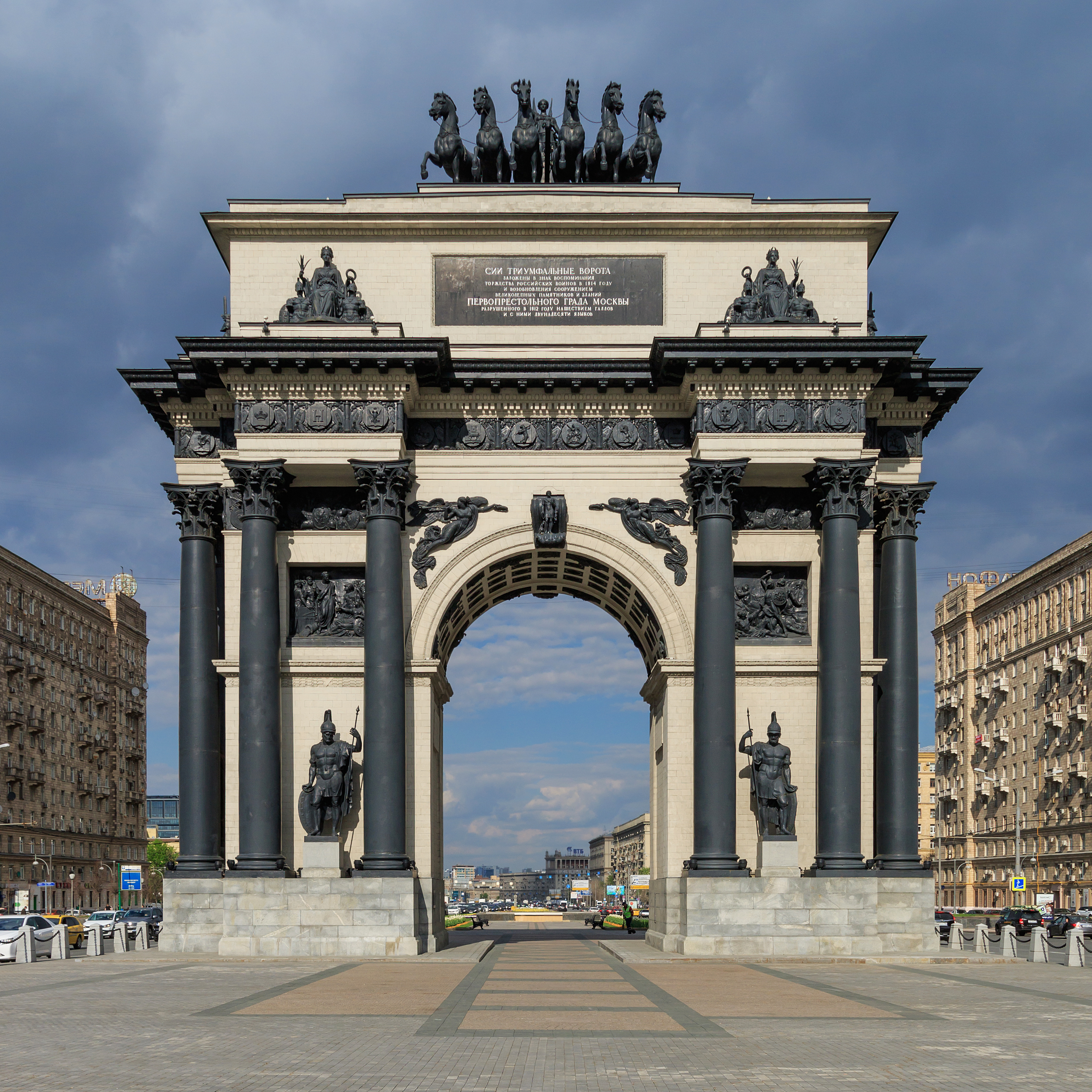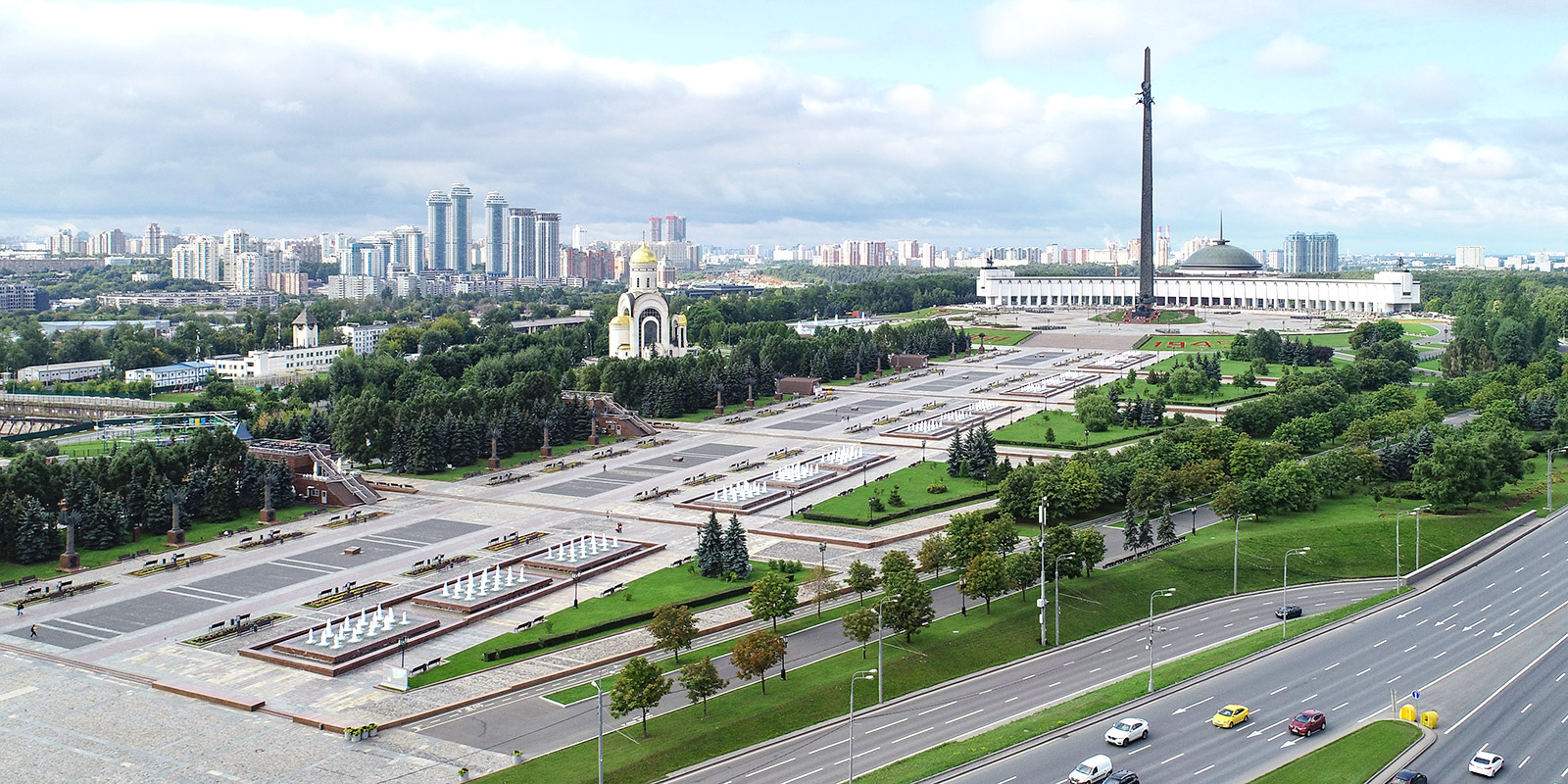|
Triumphal Arch, Moscow
The third and the oldest surviving Triumphal Arch in Moscow was built in 1829–34 on Tverskaya Zastava Square to Joseph Bové's designs in order to commemorate Imperial Russia's victory over Napoleon. It replaced an earlier wooden structure built by the veterans of the Napoleonic Wars in 1814. The arch was built in brick and lined with ashlar. The columns and statues were of cast iron. A seiuga (six-horse chariot) was designed by Giovanni Vitali Ivan Petrovich Vitali (russian: Иван Петрович Витали; 1794–1855) was a Russian sculptor of Italian people, Italian descent. Born in Saint Petersburg, he was apprenticed to his father, Pietro Vitali, from an early age. After a .... The bilingual inscription in Russian and Latin ran as follows: The arch was dismantled in 1936 as part of Joseph Stalin's reconstruction of downtown Moscow. Vitali's sculptures were then put on exhibit at an architectural museum on the grounds of the former Donskoy Monastery ... [...More Info...] [...Related Items...] OR: [Wikipedia] [Google] [Baidu] |
Moscow 05-2017 Img17 Triumphal Gate
Moscow ( , American English, US chiefly ; rus, links=no, Москва, r=Moskva, p=mɐskˈva, a=Москва.ogg) is the Capital city, capital and List of cities and towns in Russia by population, largest city of Russia. The city stands on the Moskva (river), Moskva River in Central Russia, with a population estimated at 13.0 million residents within the city limits, over 17 million residents in the urban area, and over 21.5 million residents in the Moscow metropolitan area, metropolitan area. The city covers an area of , while the urban area covers , and the metropolitan area covers over . Moscow is among the List of largest cities, world's largest cities; being the List of European cities by population within city limits, most populous city entirely in Europe, the largest List of urban areas in Europe, urban and List of metropolitan areas in Europe, metropolitan area in Europe, and the largest city by land area on the European continent. First documented in 1147, Moscow gre ... [...More Info...] [...Related Items...] OR: [Wikipedia] [Google] [Baidu] |
Gauls
The Gauls ( la, Galli; grc, Γαλάται, ''Galátai'') were a group of Celtic peoples of mainland Europe in the Iron Age and the Roman period (roughly 5th century BC to 5th century AD). Their homeland was known as Gaul (''Gallia''). They spoke Gaulish, a continental Celtic language. The Gauls emerged around the 5th century BC as bearers of La Tène culture north and west of the Alps. By the 4th century BC, they were spread over much of what is now France, Belgium, Switzerland, Southern Germany, Austria, and the Czech Republic, by virtue of controlling the trade routes along the river systems of the Rhône, Seine, Rhine, and Danube. They reached the peak of their power in the 3rd century BC. During the 4th and 3rd centuries BC, the Gauls expanded into Northern Italy ( Cisalpine Gaul), leading to the Roman–Gallic wars, and into the Balkans, leading to war with the Greeks. These latter Gauls eventually settled in Anatolia, becoming known as Galatians. After the ... [...More Info...] [...Related Items...] OR: [Wikipedia] [Google] [Baidu] |
Neoclassical Architecture In Russia
Neoclassical architecture in Russia developed in the second half of the 18th century, especially after Catherine the Great succeeded to the throne on June 28, 1762, becoming Empress of Russia. Neoclassical architecture developed in many Russian cities, first of all St. Petersburg, which was undergoing its transformation into a modern capital throughout the reign of Catherine II. Origin of the style Background As part of the European cosmopolitan class of the 18th century, Catherine set the tone of Russian social and intellectual life during her long reign. The Catherinian Era was a turning point in terms of the education of nobility, particularly in the fields of art and literature. French became the court language, and along with the language came the ideas of Enlightenment as well. Her embrace of the neo-classicism current linked her capital to ancient Rome, and this phenomenon was particularly encouraged by poetic allusions to St. Petersburg as similar to the ancie ... [...More Info...] [...Related Items...] OR: [Wikipedia] [Google] [Baidu] |
Monuments And Memorials In Moscow
A monument is a type of structure that was explicitly created to commemorate a person or event, or which has become relevant to a social group as a part of their remembrance of historic times or cultural heritage, due to its artistic, historical, political, technical or architectural importance. Some of the first monuments were dolmens or menhirs, megalithic constructions built for religious or funerary purposes. Examples of monuments include statues, (war) memorials, historical buildings, archaeological sites, and cultural assets. If there is a public interest in its preservation, a monument can for example be listed as a UNESCO World Heritage Site. Etymology It is believed that the origin of the word "monument" comes from the Greek ''mnemosynon'' and the Latin ''moneo'', ''monere'', which means 'to remind', 'to advise' or 'to warn', however, it is also believed that the word monument originates from an Albanian word 'mani men' which in Albanian language means 'remember ... [...More Info...] [...Related Items...] OR: [Wikipedia] [Google] [Baidu] |
Military Monuments And Memorials
A military, also known collectively as armed forces, is a heavily armed, highly organized force primarily intended for warfare. It is typically authorized and maintained by a sovereign state, with its members identifiable by their distinct military uniform. It may consist of one or more military branches such as an army, navy, air force, space force, marines, or coast guard. The main task of the military is usually defined as defence of the state and its interests against external armed threats. In broad usage, the terms ''armed forces'' and ''military'' are often treated as synonymous, although in technical usage a distinction is sometimes made in which a country's armed forces may include both its military and other paramilitary forces. There are various forms of irregular military forces, not belonging to a recognized state; though they share many attributes with regular military forces, they are less often referred to as simply ''military''. A nation's military may f ... [...More Info...] [...Related Items...] OR: [Wikipedia] [Google] [Baidu] |
List Of Post-Roman Triumphal Arches
This is a list of post-Roman triumphal arches. Since the Renaissance period, rulers and states have sought to glorify themselves or commemorate victories by erecting triumphal arches on the Roman model. Modern arches have ranged from temporary structures of wood and plaster set up to celebrate royal entries to large permanent stone structures built in prominent places in city centres. They have been built around the world in a variety of styles, ranging from conscious imitations of Roman arches to more loose interpretations influenced by local architectural styles. See also * List of Roman triumphal arches * Memorial gates and arches References {{refimprove, date=January 2017 Triumphal arches Triumphal arches Triumphal arches A triumphal arch is a free-standing monumental structure in the shape of an archway with one or more arched passageways, often designed to span a road. In its simplest form a triumphal arch consists of two massive piers connected by an arch, crow . ... [...More Info...] [...Related Items...] OR: [Wikipedia] [Google] [Baidu] |
Victory Square, Moscow
The term victory (from Latin ''victoria'') originally applied to warfare, and denotes success achieved in personal combat, after military operations in general or, by extension, in any competition. Success in a military campaign constitutes a strategic victory, while the success in a military engagement is a tactical victory. In terms of human emotion, victory accompanies strong feelings of elation, and in human behaviour often exhibits movements and poses paralleling threat display preceding the combat, which are associated with the excess endorphin built up preceding and during combat. Victory dances and victory cries similarly parallel war dances and war cries performed before the outbreak of physical violence. Examples of victory behaviour reported in Roman antiquity, where the term ''victoria'' originated, include: the victory songs of the Batavi mercenaries serving under Gaius Julius Civilis after the victory over Quintus Petillius Cerialis in the Batavian rebellion ... [...More Info...] [...Related Items...] OR: [Wikipedia] [Google] [Baidu] |
Poklonnaya Hill
Poklonnaya Gora (russian: Покло́нная гора́, literally "bow-down hill"; metaphorically "Worshipful Submission Hill"') is, at 171.5 meters, one of the highest natural spots in Moscow. Its two summits used to be separated by the Setun River, until one of the summits was razed in 1987. Since 1936, the area has been part of Moscow and now contains the Victory Park with many tanks and other vehicles used in the Second World War on display. Historically, the hill had great strategic importance, as it commanded the best view of the Russian capital. Its name is derived from the Russian for "to bow down", as everyone approaching the capital from the west was expected to do homage here. During the French invasion of Russia in 1812, it was the spot where Napoleon in vain expected the keys to the Kremlin to be brought to him by Russians. Victory Park In the 1960s, the Soviet authorities decided to put the area to use as an open-air museum dedicated to the Russian victory over ... [...More Info...] [...Related Items...] OR: [Wikipedia] [Google] [Baidu] |
Kutuzovsky Avenue
Kutuzovsky Prospekt (russian: Куту́зовский проспе́кт) is a major radial avenue in Moscow, Russia, named after Mikhail Illarionovich Kutuzov, leader of the Russian field army during the French invasion of Russia. The prospekt continues a westward path of Vozdvizhenka Street and New Arbat Street from ''Novoarbatsky Bridge'' over the Moskva River to the junction with ''Rublyovskoye Shosse''; past this point, the route changes its name to ''Mozhaiskoye Shosse''. Overview Present-day Kutuzovsky Prospekt emerged between 1957 and 1963, incorporating part of the old Mozhaiskoye Schosse (buildings no. 19 to 45) that was rebuilt in grand Stalinist style in the late 1930s on the site of the former Dorogomilovo Cemetery, and the low-rise neighborhoods of Kutuzovskaya Sloboda Street and Novodorogomilovskaya Street that were razed in the 1950s. Initially, Kutuzovsky Prospekt extended east to the Garden Ring; however, in 1963, at the beginning of the New Arbat redevel ... [...More Info...] [...Related Items...] OR: [Wikipedia] [Google] [Baidu] |
Moscow Belorussky Railway Station
Belorussky railway terminal (russian: Белору́сский вокза́л, ) is a Station building, passenger terminal at the ''Moscow–Passenger–Smolenskaya'' railway station (russian: Москва́-Пассажирская-Смоле́нская, also known as ''Moskva-Smolenskaya'') of the Moscow Railway. Informally the whole station can be called as ''Moscow Belorusskaya'' (russian: Москва Белорусская, ''Moskva Belorusskaya''). It is one of nine railway terminals of Moscow. It was opened in 1870 and rebuilt in its current form in 1907–1912. Operations Belorussky railway terminal serves long distance trains to regions west and south-west of Moscow, and one train each to the north-east (on the Savyolovsky branch to Rybinsk with continuing service to Uglich, Vesegonsk, and Pestovo) and to the south (to Anapa through Tula, Russia, Tula, Kursk, Voronezh, and Rostov-on-Don). The station also serves local commuter trains (Belorussky suburban railway lin ... [...More Info...] [...Related Items...] OR: [Wikipedia] [Google] [Baidu] |
Second World War
World War II or the Second World War, often abbreviated as WWII or WW2, was a world war that lasted from 1939 to 1945. It involved the vast majority of the world's countries—including all of the great powers—forming two opposing military alliances: the Allies and the Axis powers. World War II was a total war that directly involved more than 100 million personnel from more than 30 countries. The major participants in the war threw their entire economic, industrial, and scientific capabilities behind the war effort, blurring the distinction between civilian and military resources. Aircraft played a major role in the conflict, enabling the strategic bombing of population centres and deploying the only two nuclear weapons ever used in war. World War II was by far the deadliest conflict in human history; it resulted in 70 to 85 million fatalities, mostly among civilians. Tens of millions died due to genocides (including the Holocaust), starvation, ma ... [...More Info...] [...Related Items...] OR: [Wikipedia] [Google] [Baidu] |







